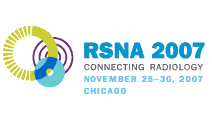
Abstract Archives of the RSNA, 2007
LL-BR2121-H02
The Role of Ultrasonography as an Adjunct Examination to Screening Mammography in Detecting Occult Breast Cancer in Women with Dense Breasts
Scientific Posters
Presented on November 27, 2007
Presented as part of LL-BR-H: Breast Imaging
Adriana Padovan Ferreira MD, Presenter: Nothing to Disclose
Kemp Claudio MD, PhD, Abstract Co-Author: Nothing to Disclose
Simone Elias MD, PhD, Abstract Co-Author: Nothing to Disclose
Vera Nunes Aguillar MD, PhD, Abstract Co-Author: Nothing to Disclose
Mello Guesdes Netto de Giselle MD, PhD, Abstract Co-Author: Nothing to Disclose
Aracava Mayumi Marcia MD, Abstract Co-Author: Nothing to Disclose
Ana Paula Coutinho Colla Maia MD, Abstract Co-Author: Nothing to Disclose
Ana Paula Atihe Benveniste MD, Abstract Co-Author: Nothing to Disclose
et al, Abstract Co-Author: Nothing to Disclose
et al, Abstract Co-Author: Nothing to Disclose
To assess breast ultrasound usefulness in asymptomatic women with dense and partially dense breasts showing negative mammographic studies and to determine the prevalence of breast cancer detected only by ultrasound in this group.
Between January 2001 and December 2001 and between November 2004 and May 2005, a total of 2142 patients with negative findings on clinical examination, negative mammographic results and BI-RADS© 2, 3 or 4 mammographic density category were evaluated with bilateral whole-breast US for occult abnormalities. The solid masses found have been classified as BI-RADS© 3 or 4 category and submitted, respectively, to ultrasound control and ambulatory or surgical biopsy.
Out of 2142 negative mammographies, 19 solid masses were classified as suspicious (category 4). Among those 19 solid masses, 9 were benign, 9 were malignant (detection rate: 0.42%) and one patient was lost on follow-up. The average size of tumors diagnosed only by ultrasound was 0.84 cm. The most common histological type was ductal NOS (4/9), followed by lobular (3/9), ductal and lobular (1/9) and papillary (1/9). No carcinoma “in situ” was detected. A total of 1602 patients (74.8%) were followed by imaging for up to 93 months (average of 35.7 months, standard deviation of 18.3 months). Out of the three breast cancer cases not detected by ultrasound at a time-interval smaller than 1 year, one patient showed a palpable mass, in another the mass could be observed in the follow-up ultrasound and, in the last one, the mass described as BIRADS® category 3 was shown to be enlarged at the ultrasound control. A total of 66 biopsies were performed, 45 in masses classified as category 3, 18 in category 4 masses and 3 in masses which characteristics became suspicious within less than one year. Sensitivity, specificity, negative and positive predictive values were 75.0%, 99.4%, 99.8% and 50.0%.
The 0.42% cancer detection rate is similar to that of screening mammography.
Bilateral whole-breast US, when performed in patients with BI-RADS© 2, 3 or 4 density breast tissue, is useful in detecting small breast cancers that are not detected on mammography.
Ferreira, A,
Claudio, K,
Elias, S,
Aguillar, V,
Giselle, M,
Marcia, A,
Maia, A,
Benveniste, A,
et al, ,
et al, ,
The Role of Ultrasonography as an Adjunct Examination to Screening Mammography in Detecting Occult Breast Cancer in Women with Dense Breasts. Radiological Society of North America 2007 Scientific Assembly and Annual Meeting, November 25 - November 30, 2007 ,Chicago IL.
http://archive.rsna.org/2007/5006141.html

